You might start a class blog to . . .
• Create, collaborate, and communicate online, in an authentic and respectful way
• Allow students to express their thoughts and ideas
• Post class calendars, events, homework assignments
• Communicate with parents & community
• Create student portfolio
• Post prompts for writing
• Provide examples of class work, vocabulary activities, or grammar games
• Provide online readings
• Gather and organize Internet resources
• Provide links to appropriate sites
• Post photos, videos
• Embed online video, multimedia presentations, slideshows
• Invite student comments or postings on issues in order to give them a writing voice
• Publish examples of good student writing, drawings, multi-media presentations
• Showcase student art, poetry, and creative stories
• Create on online book club
• Create polls, quizzes, and activities
• Have students create their own blogs
• Post tasks to carry out project-based learning tasks
• Link your class with another class somewhere in the world
• Foster meaning and ownership
• Inspire learning
• Allow students to express their thoughts and ideas
• Post class calendars, events, homework assignments
• Communicate with parents & community
• Create student portfolio
• Post prompts for writing
• Provide examples of class work, vocabulary activities, or grammar games
• Provide online readings
• Gather and organize Internet resources
• Provide links to appropriate sites
• Post photos, videos
• Embed online video, multimedia presentations, slideshows
• Invite student comments or postings on issues in order to give them a writing voice
• Publish examples of good student writing, drawings, multi-media presentations
• Showcase student art, poetry, and creative stories
• Create on online book club
• Create polls, quizzes, and activities
• Have students create their own blogs
• Post tasks to carry out project-based learning tasks
• Link your class with another class somewhere in the world
• Foster meaning and ownership
• Inspire learning
Create Static Pages in Blogger
Blogger Static Pages
Creating a static page:
1. Go to the settings (customize) area for your blog.
2. Click the Posting tab.
3. Click the Edit Pages link.
4. Click the New Page button.
Adding Information to the Static Page:
1. Enter a page title.
2. Enter the desired information. Note - in this area you can add text, pictures, hyperlinks, and even embed code!
3. Click the Publish Page button.
4. Determine whether you want the links to the pages to appear in the blog sidebar or at the top under the title.
Creating a static page:
1. Go to the settings (customize) area for your blog.
2. Click the Posting tab.
3. Click the Edit Pages link.
4. Click the New Page button.
Adding Information to the Static Page:
1. Enter a page title.
2. Enter the desired information. Note - in this area you can add text, pictures, hyperlinks, and even embed code!
3. Click the Publish Page button.
4. Determine whether you want the links to the pages to appear in the blog sidebar or at the top under the title.
Subscribe to:
Comments (Atom)












